How to deal with places which proof the bad side of your history? Hide, forget or show? For over 15 years I visit these 'Böse Orte': Places with a history of WW2 where things were built in secret. Mostly from the thought of Hitler's megalomania.
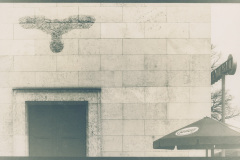
From March 8th to June 30th, Walter Sans exhibits at the Zandvoort Museum with the exhibition 'Böse Orte' (Evil Places). Over the past 15 years, he has visited all kinds of evil locations from the Second World War. Central to this is the question: "How do to deal with these places?"
These are all new handprinted cyanotypes
These are all new handprinted cyanotypes
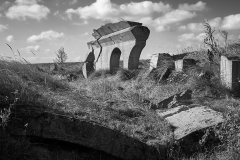
From 1936 to 1945, the research stations in Peenemünde formed the largest armaments centre in Europe. Over an area of 25km², up to 12,000 people worked simultaneously on guided weapons, most famously the world’s first cruise missiles and the first ever functioning large-scale rockets. Both were designed as a weapon of terror against the civil population, made mostly by forced labourers and from 1944 they began to be used in the Second World War as “Vergeltungswaffen” (V-weapons).
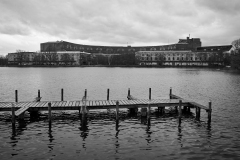
The Nazi Party Rallies, held in Nuremberg from 1933 to 1938, served most of all to stage-manage the image of the regime and Adolf Hitler, and to theatricalize the racially rooted myth of the "community of the Volk" and the population's backing of the war. The rallies themselves, which could last for up to eight days, were only one highlight in a whole year of National Socialist ceremonies.

16 Meter beneath Berlin Tiergarten three vast tunnels give a glimpse of Adolf Hitler’s megalomaniac vision of a new architectural centre for the capital of Nazi Germany.
The tunnels were constructed in 1938 as part of an underground transport network beneath a series of bombastic buildings designed by Nazi architect Albert Speer, including the biggest domed hall the world had ever seen.
The overground plans, never completed because of World War Two, included boulevards, squares and huge buildings,. Hitler called the concept, a symbol of the power of the Third Reich, “Berlin — the capital of the world” but in recent times it has come to be known as “Germania”.
The tunnels, between 90 and 220 meters long lying beneath the Tiergarten park, would have accommodated roads and a railway line.
I visited the tunnels in 2009.
The tunnels were constructed in 1938 as part of an underground transport network beneath a series of bombastic buildings designed by Nazi architect Albert Speer, including the biggest domed hall the world had ever seen.
The overground plans, never completed because of World War Two, included boulevards, squares and huge buildings,. Hitler called the concept, a symbol of the power of the Third Reich, “Berlin — the capital of the world” but in recent times it has come to be known as “Germania”.
The tunnels, between 90 and 220 meters long lying beneath the Tiergarten park, would have accommodated roads and a railway line.
I visited the tunnels in 2009.
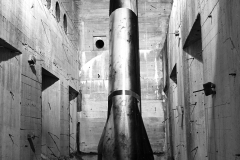
Blockhaus d'Éperlecques is a Second World War bunker, now part of a museum, near Saint-Omer in northern France.
The bunker, built by Nazi Germany under the codename Kraftwerk Nord West between March 1943 and July 1944, was originally intended to be a launching facility for the V-2 (A-4) ballistic missile. It was designed to accommodate over 100 missiles at a time and to launch up to 36 daily.
The facility would have incorporated a liquid oxygen factory and a bomb-proof train station to allow missiles and supplies to be delivered from production facilities in Germany. It was constructed using the labour of thousands of prisoners of war and forcibly conscripted workers used as slave labourers.
The bunker was never completed as a result of the repeated bombing by the British and United States air forces as part of Operation Crossbow against the German V-weapons programme.
The bunker, built by Nazi Germany under the codename Kraftwerk Nord West between March 1943 and July 1944, was originally intended to be a launching facility for the V-2 (A-4) ballistic missile. It was designed to accommodate over 100 missiles at a time and to launch up to 36 daily.
The facility would have incorporated a liquid oxygen factory and a bomb-proof train station to allow missiles and supplies to be delivered from production facilities in Germany. It was constructed using the labour of thousands of prisoners of war and forcibly conscripted workers used as slave labourers.
The bunker was never completed as a result of the repeated bombing by the British and United States air forces as part of Operation Crossbow against the German V-weapons programme.
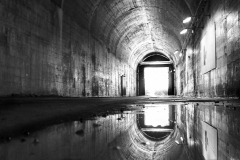
Mimoyecques Fortress, also called « The London Gun » is one of the most impressive military units imagined by Hitler. Located at the North of France, this secret underground base was meant to be used for the installation of the V3 super gun
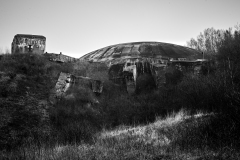
La Coupole, located 5 km from Saint-Omer (Nord-Pas-de-Calais), is one of the most impressive remnants of the Second World War in Europe. It is a symbolic place of the Nazi oppression, due to its overwhelming mass, the nature of its underground facilities and the suffering of the slave labourers who built it.
This huge bunker, built by the Todt Organisation in 1943-1944 had to be the base for launching the V2 rockets against London. Developed in the ultra-secret Peenemünde centre by Von Braun's team, these missiles, along with the American atomic bomb, were the most innovative devices developed during World War II. The V2s were mass-produced by deportees from the Dora concentration camp in the underground factory "Mittelwerk", located at the heart of Germany.
Heavily bombed by the Allies, La Coupole was abandoned during the summer of 1944, after the Normandy landings. The V2s, which struck London and Antwerp in September 1944, were launched by mobile units established in Holland.
Since 1997, this place, which has been turned into a History and Memory Centre, a world war II museum.
This huge bunker, built by the Todt Organisation in 1943-1944 had to be the base for launching the V2 rockets against London. Developed in the ultra-secret Peenemünde centre by Von Braun's team, these missiles, along with the American atomic bomb, were the most innovative devices developed during World War II. The V2s were mass-produced by deportees from the Dora concentration camp in the underground factory "Mittelwerk", located at the heart of Germany.
Heavily bombed by the Allies, La Coupole was abandoned during the summer of 1944, after the Normandy landings. The V2s, which struck London and Antwerp in September 1944, were launched by mobile units established in Holland.
Since 1997, this place, which has been turned into a History and Memory Centre, a world war II museum.

Prora, also known as the Colossus of Prora, is a building complex on the island of Rügen, Germany, that was built by Nazi Germany between 1936 and 1939 as a beach resort of the Streng Through Joy (Kraft durch Freude or KdF) project. It consisted of eight identical buildings and was 4.5 km in length parallel to the beach, with the surviving structures stretching 3.0 km.
The KdF-seaside resort Rügen was an important element of the social propaganda of the "Third Reich". As the largest architectural project of the "Third Reich" Prora is of high importance both with its building history and social history.
Although the buildings were planned as a holiday resort, construction was not completed and they were not used for this purpose. After World War II, the complex found various military uses, first by the Soviet Army, then by the East German Volksarmee, and then by the German Bundeswehr. I visited it in 2007 when it was still abandoned. Today it houses a large youth hostel, a hotel and vacation apartments.
The KdF-seaside resort Rügen was an important element of the social propaganda of the "Third Reich". As the largest architectural project of the "Third Reich" Prora is of high importance both with its building history and social history.
Although the buildings were planned as a holiday resort, construction was not completed and they were not used for this purpose. After World War II, the complex found various military uses, first by the Soviet Army, then by the East German Volksarmee, and then by the German Bundeswehr. I visited it in 2007 when it was still abandoned. Today it houses a large youth hostel, a hotel and vacation apartments.
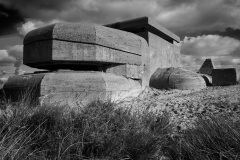
The Atlantic Wall (German: Atlantikwall) was an extensive system of coastal defences and fortifications built by Nazi Germany between 1942 and 1944 along the coast of continental Europe and Scandinavia as a defence against an anticipated Allied invasion of Nazi-occupied Europe from the United Kingdom, during World War II. The manning and operation of the Atlantic Wall was administratively overseen by the German Army, with some support from Luftwaffe ground forces. The Kriegsmarine maintained a separate coastal defence network, organised into a number of sea defence zones.

All motorway construction in Germany was stopped in 1943 because of the war.
The ruins of Section 46 between Gemünden and Bad Brückenau were taken over by woods again. They were lost in oblivion.
Section 46 became ‚The forgotten motorway’.
The ruins of Section 46 between Gemünden and Bad Brückenau were taken over by woods again. They were lost in oblivion.
Section 46 became ‚The forgotten motorway’.
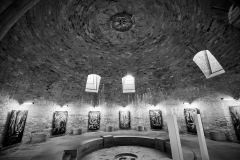
n 1933, SS leader Heinrich Himmler designated Wewelsburg Castle as the ideological "center of the world" for the elite Nazi corps. The castle was built between 1603 and 1609 by the Prince of Paderborn. In 1934 Himmler decided to rent the castle for the symbolic amount of 1 Reichsmark per year.
Himmler wanted to convert the Wewelsburg Castle and redesign it as 'Reichsführerschule SS'.
In addition, Wewelsburg was also to become the headquarters of the SS.
To make the castle suitable for this, many forced laborers had to work on the castle
Himmler wanted to convert the Wewelsburg Castle and redesign it as 'Reichsführerschule SS'.
In addition, Wewelsburg was also to become the headquarters of the SS.
To make the castle suitable for this, many forced laborers had to work on the castle
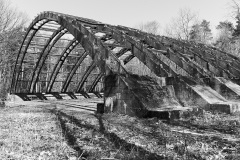
The former airbase Venlo Herongen was between October 1940 and March 1941 established as a German airfield on the Groote Heide near Venlo and was named: Fliegerhorst Venlo. The complex with two runways of 1450 meters and 1200 meters of one was equipped with the latest safety equipment, radio equipment, night lights and was the upfollowing years expanded several times.

In the 1930s, a contested wall was built on the Goudseberg near Lunteren. Standing on a small balcony, leader Anton Mussert of the National Socialistic Movement (NSB), allied to the Nazi’s, addressed his ideas in speeches for large groups of followers from this wall. Currently, after years of neglect, this Wall of Mussert is in decay.
